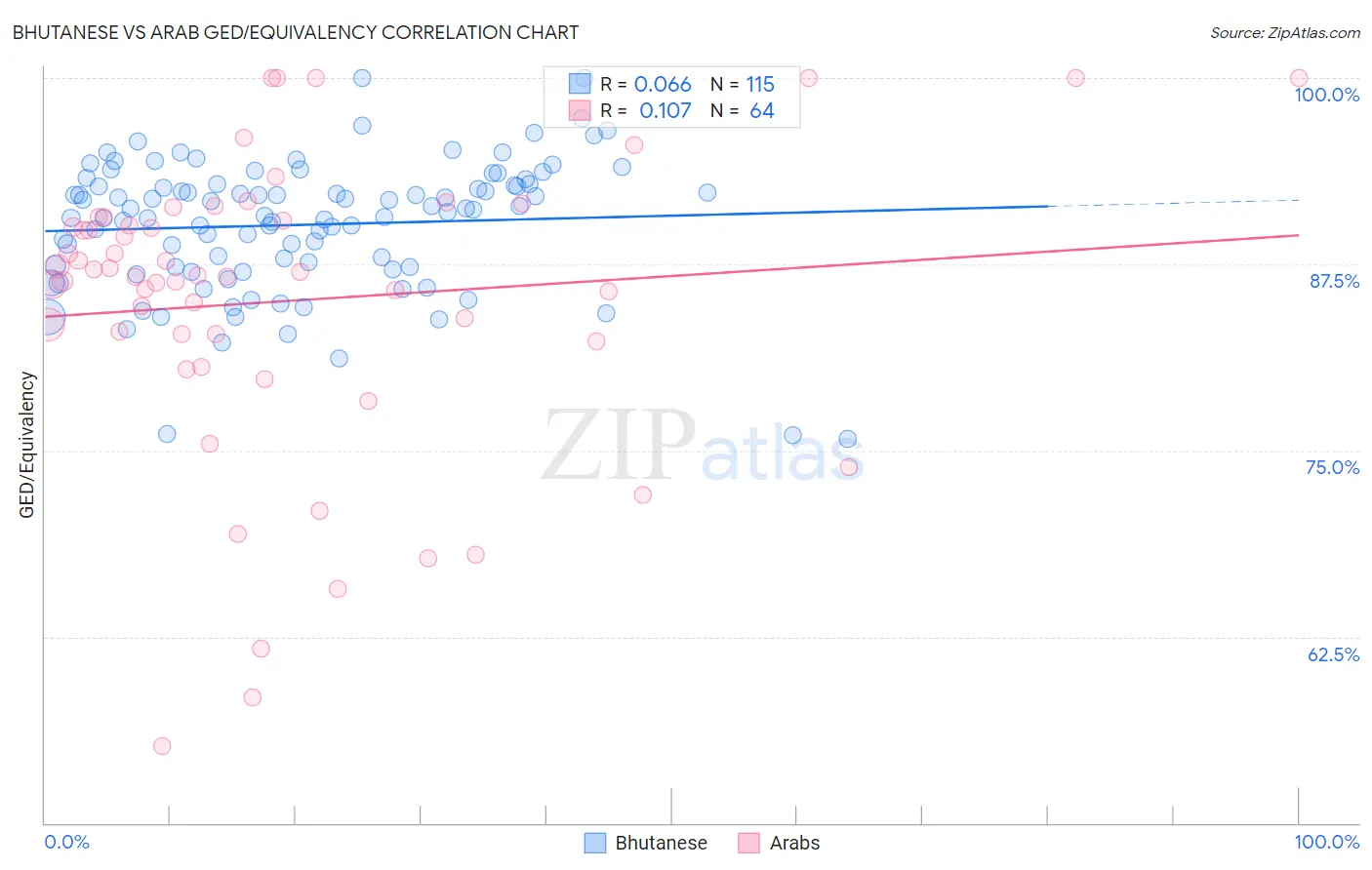Bhutanese vs Arab GED/Equivalency
COMPARE
Bhutanese
Arab
GED/Equivalency
GED/Equivalency Comparison
Bhutanese
Arabs
88.4%
GED/EQUIVALENCY
99.8/ 100
METRIC RATING
31st/ 347
METRIC RANK
86.6%
GED/EQUIVALENCY
86.7/ 100
METRIC RATING
137th/ 347
METRIC RANK
Bhutanese vs Arab GED/Equivalency Correlation Chart
The statistical analysis conducted on geographies consisting of 455,590,907 people shows a slight positive correlation between the proportion of Bhutanese and percentage of population with at least ged/equivalency education in the United States with a correlation coefficient (R) of 0.066 and weighted average of 88.4%. Similarly, the statistical analysis conducted on geographies consisting of 486,870,847 people shows a poor positive correlation between the proportion of Arabs and percentage of population with at least ged/equivalency education in the United States with a correlation coefficient (R) of 0.107 and weighted average of 86.6%, a difference of 2.2%.

GED/Equivalency Correlation Summary
| Measurement | Bhutanese | Arab |
| Minimum | 75.7% | 55.1% |
| Maximum | 100.0% | 100.0% |
| Range | 24.3% | 44.9% |
| Mean | 90.2% | 85.0% |
| Median | 91.1% | 86.7% |
| Interquartile 25% (IQ1) | 87.3% | 82.6% |
| Interquartile 75% (IQ3) | 92.9% | 90.6% |
| Interquartile Range (IQR) | 5.6% | 8.0% |
| Standard Deviation (Sample) | 4.5% | 9.9% |
| Standard Deviation (Population) | 4.5% | 9.9% |
Similar Demographics by GED/Equivalency
Demographics Similar to Bhutanese by GED/Equivalency
In terms of ged/equivalency, the demographic groups most similar to Bhutanese are Danish (88.4%, a difference of 0.020%), Turkish (88.5%, a difference of 0.030%), Polish (88.5%, a difference of 0.050%), Immigrants from Sweden (88.4%, a difference of 0.060%), and Immigrants from Japan (88.4%, a difference of 0.070%).
| Demographics | Rating | Rank | GED/Equivalency |
| Slovaks | 99.8 /100 | #24 | Exceptional 88.6% |
| Estonians | 99.8 /100 | #25 | Exceptional 88.6% |
| Immigrants | Australia | 99.8 /100 | #26 | Exceptional 88.6% |
| Immigrants | Lithuania | 99.8 /100 | #27 | Exceptional 88.6% |
| Immigrants | Northern Europe | 99.8 /100 | #28 | Exceptional 88.5% |
| Poles | 99.8 /100 | #29 | Exceptional 88.5% |
| Turks | 99.8 /100 | #30 | Exceptional 88.5% |
| Bhutanese | 99.8 /100 | #31 | Exceptional 88.4% |
| Danes | 99.8 /100 | #32 | Exceptional 88.4% |
| Immigrants | Sweden | 99.7 /100 | #33 | Exceptional 88.4% |
| Immigrants | Japan | 99.7 /100 | #34 | Exceptional 88.4% |
| Immigrants | South Central Asia | 99.7 /100 | #35 | Exceptional 88.4% |
| Immigrants | Belgium | 99.7 /100 | #36 | Exceptional 88.3% |
| Immigrants | Austria | 99.7 /100 | #37 | Exceptional 88.3% |
| Burmese | 99.7 /100 | #38 | Exceptional 88.3% |
Demographics Similar to Arabs by GED/Equivalency
In terms of ged/equivalency, the demographic groups most similar to Arabs are Chilean (86.6%, a difference of 0.010%), Immigrants from Argentina (86.6%, a difference of 0.010%), Immigrants from Asia (86.6%, a difference of 0.030%), Albanian (86.6%, a difference of 0.040%), and Immigrants from Malaysia (86.5%, a difference of 0.070%).
| Demographics | Rating | Rank | GED/Equivalency |
| Immigrants | Germany | 88.8 /100 | #130 | Excellent 86.7% |
| Immigrants | Spain | 88.5 /100 | #131 | Excellent 86.7% |
| Immigrants | Brazil | 88.4 /100 | #132 | Excellent 86.6% |
| Tsimshian | 88.3 /100 | #133 | Excellent 86.6% |
| Albanians | 87.7 /100 | #134 | Excellent 86.6% |
| Immigrants | Asia | 87.4 /100 | #135 | Excellent 86.6% |
| Chileans | 86.9 /100 | #136 | Excellent 86.6% |
| Arabs | 86.7 /100 | #137 | Excellent 86.6% |
| Immigrants | Argentina | 86.5 /100 | #138 | Excellent 86.6% |
| Immigrants | Malaysia | 85.0 /100 | #139 | Excellent 86.5% |
| Paraguayans | 84.1 /100 | #140 | Excellent 86.5% |
| Laotians | 83.2 /100 | #141 | Excellent 86.5% |
| Immigrants | Indonesia | 82.4 /100 | #142 | Excellent 86.4% |
| Immigrants | Pakistan | 82.4 /100 | #143 | Excellent 86.4% |
| Bolivians | 82.1 /100 | #144 | Excellent 86.4% |